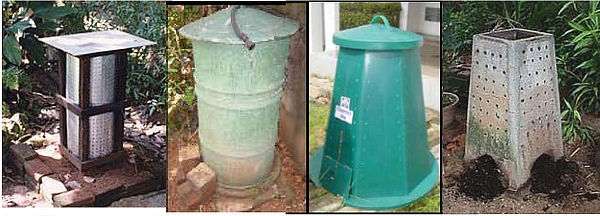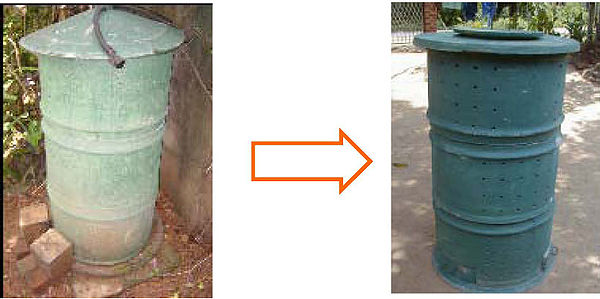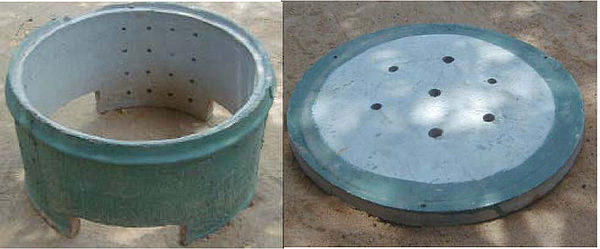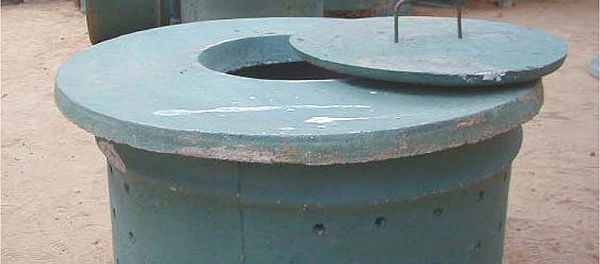How to Home Compost
HOME COMPOSTING
Contents
- 1 BINS
BINS
Introduction
Home Composting is not a new technology and it has been practiced for many years around the world, as a simple and low cost solution to manage household organic waste at source.
Compost offers several benefits such as enhanced soil fertility and soil health-thereby increased agricultural productivity, improved soil biodiversity, reduced ecological risks and a better environment.
Home composting is now being encouraged as a means of reducing the organic waste being discarded and sent to the landfills. In Sri Lanka, organic fraction of Municipal Solid Waste (MSW) contributes 70 - 90% of total waste stream in many municipalities. These organic substances are bulky to handle and contributes for numerous liquid and gaseous emissions that deteriorate dumpsite environments. A good home composting programmes can:
- Significantly reduce the quantity of organic waste adding to the mainstream (>50%) and subsequent emissions upon final disposal.
- Valuable products (compost) are produced while reducing the costs incurred for collection, transportation and final disposal at dumpsite.
- Home composting encourages the community involvement on waste management activities and it facilitates easy transferring of source separation concepts to the people. Community participation has been a vital component in most successful integrated solid waste management (ISWM) programmes.
- Home based composting compared to the compost produced from mixed waste is of high quality as the waste does not get contaminated with hazardous materials.
- The separated inorganic materials need less effort for cleaning before recycling.
Therefore, household composting has been identified as an option to enhance the economic conditions of urban poor people through home-gardening and selling of compost and/or recyclables. The collection and composting of organic waste can also become a new income source for the formal or informal economy.
There are various technical options available as household level composting systems that vary from simple pit /heap methods to complex bin or rotating drum designs.
Traditional composting methods (pit, heap, Jeewakotu) have been common practices in many rural/ peri-urban areas with different kinds of organic matters. Most urban dwellers prefer bin composting system due to its convenience and as it has less impact an aestheticism with their very limited space.In Sri Lanka, different set-ups of household composting units can be found and it has been more popularised in some areas.
The Composting Process
Composting is a natural biological process that is carried out under controlled aerobic (requires oxygen) or anaerobic (without oxygen) conditions.
Anaerobic composting is not common due to its slow degradation rate and odorous intermediate products.
Aerobic composting is widely used and in this process, various microorganisms, including bacteria and fungi, break down organic matter into simpler substances. The effectiveness of the composting process is dependent upon the environmental conditions present within the composting system i.e. oxygen, temperature, moisture, material disturbance, substrate conditions.
The essential elements required by the composting microorganisms are Carbon, Nitrogen (represent by C: N ratio), Oxygen and Moisture. If any of these elements are lacking, or if they are not provided in the proper proportion, the microorganisms will not flourish and will not provide adequate heat.
A composting process that operates at optimum performance will convert organic matter into stable compost that is odour and pathogen free, while a poor breeding (mix and care) will become ideal substrate for flies.
A good composting process will significantly reduce the volume and weight of organic waste as the composting process converts much of the biodegradable component to gaseous carbon dioxide and water.
Composting is relatively simple to manage and can be carried out on a wide range of scales in almost any indoor or outdoor environment and in almost any geographic location. It has the potential to manage most of the organic material in the waste stream including kitchen waste, leaves and yard wastes, farm waste, animal manure, paper products, sewage sludge etc.
All that makes composting a vital component for an integrated waste management plan.
Optimum conditions for composting
Oxygen / aeration
If there is insufficient oxygen, a different set of anaerobic microorganism dominates the degradation process and produce odorous intermediate products such as methane, organic acids and hydrogen sulphide. A constant supply of oxygen will give the aerobic microorganisms an advantage over the anaerobic micro-organisms. Approximately a 5% minimum concentration of oxygen is required within the pore spaces in the media.
Aeration is the process of providing oxygen into the composting material, for example by returning the heap. This will also provide a platform to remove water vapour, gases and excess heat trapped within the material. Automatic aeration is common practice with high rate large scale composting facilities.
Moisture content
Moisture supports the metabolic processes of the Micro-organisms. Water is the medium for chemical reactions. Biological activity ceases below 15% moisture content and in theory activity is optimal when materials are saturated. Generally moisture content of between 40% and 65% should be maintained. At moisture content of below 40%, micro-organism activity will continue but at a slower rate and above 65% water will displace much of the air in the pore spaces of the composting material. This will limit the movement of air and lead to anaerobic conditions.
Temperature
-going microbial activity. At these temperatures many micro-organisms die or become dormant and the process effectively stops until the micro-organisms can recover.
Nutrients and the Carbon to Nitrogen (C:N) ratio
The microbes involved in composting use carbon for energy and nitrogen for proteinsynthesis. The proportion of these two elements required by the microbes averages about 30 parts carbon to 1 part nitrogen. Accordingly, the ideal ratio of Carbon to Nitrogen (C: N) is 30 to 1 (measured on a dry weight basis). This ratio governs the speed at which the microbes decompose organic waste. Most organic materials do not have this ratio and, to accelerate the composting process, it may be necessary to balance the numbers by mixing different substrates. (eg.. kitchen waste is rich in nitrogen while garden waste is in poor)
Particle size, porosity, structure and texture
The ideal particle size is around 5 to 8 cm (2 to 3 inches). In some cases, such as in the composting of kitchen waste, the raw material may be too dense to permit adequate air flow or may be too moist. A common solution to this problem is to add a bulking agent (straw, dry leaves) to allow for proper air flow. Mixing materials of different sizes and textures also helps aeration the compost pile.
Home composting methods
Large scale, commercialised composting facilities (Ex. Windrows, Static piles and Reactor systems) use sophisticated technologies and equipments to handle the composting process. Home composting depends on traditional or small scale simplified composting technologies at low cost. (Ex. simple pit method, heap method, bins, rotating drums). But each method uses the same scientific principle though it differs in procedures and equipments used. Appropriate/most suitable home composting systems may differ from place to place depending on climate conditions, economic conditions and social factors of the people. In Sri Lanka, space limitation has been a critical issue for many local authorities that have crippled the implementation of home composting programmes.
Most common home composting systems in Sri Lanka
- Heap method
- Pit method
- Traditional Jeewakotu and basket methods
- Rotating drums
- Composting bin systems
Composting Bin System
Bin composting is the most popular and advance version of home composting system that overcomes problems experienced in other composting systems. There are different types of bins available for home composting and generally it varies from 200- 300L in size. These are from different materials such as cement/concrete, plastic, metal, etc. The bins allow higher stacking of composting materials and better use of floor space than free-standing piles. Bins can also eliminate weather problems and reduce problems of odours, and provide better temperature control. At present, most bins are designed to suit the urban landscape as well.
As mentioned before, composting bins are popular in urban areas with emerging solid waste disposal problems and therefore, it is important to give proper guidance to the community in using composting bins. It is identified that some technical and management problems have been the main constraints in popularising the composting bin among citizens.
The bin design should facilitate the composting process with easy management practices. Therefore, standard bin design should focus on;
- Easy transportation and installation:
- Good aeration (sufficient aeration for all parts of the bin - aeration hole diameter - < 1cm)
- Drain the excess moisture (porous bottom pad)
- Protect from external whether conditions, mainly rain, winds (proper cover or lid)
- Retain the temperature inside (dimensions of the bin and material used for constructing)
- Easy adding and mixing of waste ( proper height ,easy handling lid)
- Easy removal of compost (size and number of compost removing doors)
- Keeps away from the pest like rats, dogs crows etc.
- Durability of the bin (material used, strength etc)
As management practices, more care should be taken on selecting suitable materials for composting. In most systems, 98% of the biodegradable can be composted without much problem. But in urban areas, as there are space limitations, any form of malfunction in the composting process can lead to environmental issues in the surroundings.
Recommendation for design improvement
A) Material of the bin
- Metal composting bins are not suitable due to high corroding problems
- The economic benefit of the concrete composting bin is higher than the metal bin due to longer life span.
- Plastic bins are convenient to use but cost is high compared to other designs and it does not give a good protection especially against the rodents.
B) Design modification in concrete bin
Design modifications were done with considering the scientific requirement of the composting process and practical problems experienced by the users.
Concrete bin widely used in Sri Lank'a 'Bin with modifications
When bin designs were identified at the beginning, it did not include aeration holes in the bottom ring. Aeration is a critical factor for composting process and as a result, delayed composting and bad odour problems were identified.
The bin modified by Practical Action includes the following features:
- To improve the aeration, the modified bin was designed with more aeration holes. 70 - 100 holes were included in each ring and the diameter of these holes was less than 1cm (this minimise pest entering).
- Some designs included a bottom pad which enabled the bin to stand steadily and prevent rats entering. But, it was not porous enough to drain excess moisture. Therefore, the new design included a permeable pad with 5-
- Design Improvements for a solid lid is important for easy handling and to prevent pests entering. Prior to the solids lids, there were galvanized lids that were of light weight. These lids did not cover the bins properly as they were not steady. Therefore, a thin concrete lid was designed to cover the bin well so that the lid would not fall off. As these concrete lids are solid, it keeps away from pest and prevents any rain water entering.
- In the new design, all breakable components are reinforced with irons which help to withstand under rough handling. Therefore, it gives extra strength to the new bin with three compost removing doors.
- Rats entering the bin was a major problem that was encountered before in earlier designs with poorly fitted doors. The modified design includes a simple locking system to keep the bin door tightly closed to prevent any pests entering the bin.
- In the new design, each ring is well fitted with interlocking groves. This minimises displacing of rings with mixing and other management activities. It also keeps minimum space to protect from snails and cockroaches.
Malfunctions are caused primarily when non-degradable materials are added to the composting bin. (Table: 1)
| Materials to include | Materials to exclude |
| Vegetables/kitchen refuses Garden trimmings, grass clippings Leaves, dry leaves (straw) Twigs and shredded branches Food refuses :bread, buns etc Egg shells Farm animal manure (e.g. Cow, Sheep, Goat , Poultry) Fruit refuses Wood ash | Non biodegradable waste: polythene, plastics, glass, metal etc. Human faeces, pet manure(e.g. dog, cat) Dairy Products Diseased plants Fish , meat scraps and bones Slow degradable materials like coconut shells, coconut husk, komba etc. Fats/cooking oils Hazardous material like batteries, bulbs, electronic components, chemicals |
How to use a compost bin
1. Correct Locating of the bin
Bins should be located on a suitable place of the garden with convenient distance from the kitchen (5 - 15 m) .This place should not be a water logged area during the rainy season and a good basement is required for a steady installation. The basement should allow the drainage of excess water and it should permit the entry of soil microorganisms, earthworms etc. It is important to ensure that rats or any other pests should not enter tot the bin. It is best that the bin is placed in a sunny area to enable better composting in high temperatures (Thermophlic composting).
2. Adding the materials for composting & maintenance
- Fill the bin with household organic waste as alternative layers of kitchen waste and dried garden waste. Do not add inorganic (polythene, plastic, glass, metal) or slow degradable materials like coconut husk, coconuts shells, banana stalk etc.(table:1)
- some twigs and branches can be shredded into smaller pieces so that it accelerate the composting process
- Do not add any problematic materials like meat scraps, fish, dairy products and oily products to the bin (this attract pest). Smaller quantities of above waste can burry in the centre of bin to minimise pest attraction and malfunctions. Further, good monitoring mechanisms are needed to optimise the composting process.
- Composting cannot occur without moisture and therefore, spray some water to moist the dry materials in a bin. Too much moisture creates anaerobic conditions that can create unpleasant odours (moist but should not squeeze out water from the bin).
- Balance substrate is required for optimum growth of the micro-organisms. One material alone is sometimes not good substrate for composting and it can overcome by mixing different substrate which is rich in different components (e.g. dry garden waste with kitchen waste). Kitchen waste alone provides good substrate for fly breeding and it can minimize by covering a thin layer of dry garden waste.
- The lid of the composting bin has to be secured to prevent pests getting in. When pests such as ants and cockroaches enter the bin will also indicate that the material in the bin is too dry.
Troubleshooting
Table: 2 Common problems, causes and solutions for composting bin users
| Problems | Possible Causes | Solution |
|---|---|---|
| Materials in the bin not decomposing or not heating up at all. | Not enough nitrogen Not enough oxygen Not enough moisture | Make sure you have enough nitrogen rich sources like manure, grass clippings or food scraps. Mix up the materials in the bin, so that it can breathe. Add some water to the bin and make sure there is enough moisture for composting process. |
| Matted leaves or grass clippings are not decomposing. | Poor aeration Lack of moisture. | Avoid adding thick layers of same material. Use of one substrate alone does not provide balance nutrients for microbes. Eg. Leaves, paper, grass clippings. Therefore, shred and mixe such material with other material to help composting easy and faster. Break up the layers and mix the materials in the bin. |
| Stinks like rancid | Not enough | Mix up the bin for aeration so that it can |
| butter, vinegar or | oxygen, | breathe. |
| rotten eggs. | Bin is too wet, or compacted. | Add course dry materials like straw, hay or leaves to soak excess moisture. Add dry materials and mix well, if it creates an unpleasant odour. |
| Vermin problem | Inappropriate | Adjust the moisture by adding dry |
| (fly larvae) | materials like meat, dairy products Bin is too wet Poor aeration | materials or ash. Locate the bin in a sunny place. Heat helps to destroy fly larvae, weed seeds and other pathogens. Switch to a fly-proof closed bin with enough aeration. |
| Odour like ammonia. | Not enough carbon. | Add brown materials like dried leaves, straw, hay, shredded paper, etc. |
| Attracts rodents, | Inappropriate | Do not add inappropriate materials to a |
| flies, or other | materials (like | compost bin (large scale). |
| animals (rats, | meat, oil, bones), | Switch to a rodent-proof safe bin. |
| crows, dogs etc.) | Material like fresh food is too close to the surface of the bin. | |
| Attracts insects, millipedes, slugs, etc. | This is normal in composting and part of the natural degradation process. | Sometimes become a problem. Use proper bin design which can keep away from household pest like cockroaches, slugs, spiders |
Table: 3. Advantages and disadvantages of composting bins
| Advantages | Disadvantages |
| Management practices are easy since it eliminates external weather conditions. Minimum animal/pest attractions due to safe bin designs. Improve hygiene conditions of the surrounding environment. Takes less space in the garden. The unit is movable and can locate on any place in the garden Aesthetically good looking | High cost for purchasing(Rs. 1000/- to 2500/-) Improper/poor designs create problems and therefore it can discourage bin users. Need proper maintenance ( if proper moisture level is not maintained unpleasant odour, and vermin problems will occur) Some poor designs stops contribution of soil micro-organisms and earthworms to the degradation process. |
Compost collection can be commenced 2-3 months after starting the bin. The time taken for composting depends on the material added to the bin and maintenance practices that are followed. Removed compost must heap up outside (1-2 weeks) for maturation. This reduces the phytotoxic compounds in the compost. In order to obtain a uniform product, this compost is sent through a 4 mm mesh. Oversize particles can be sent back to the bin for further decomposition.
The quality of the compost
The following features are visible when the compositing is completed in a proper manner.
Good quality control programme is required if it is intended to market or commercialise the product, targeting the large scale agricultural systems (especially for organic farming).
- Dark brown to black in colour.
- Practically insoluble in water.
- Has a C/N Ratio ranging from 10 to 20.
- Has a beneficial effect both on the soil and the growing crops.
- Free from weed seeds and pathogens. But precaution is necessary when using compost produced from mixed garbage. This compost may be contaminated with:
- Heavy metals of Arsenic, Lead, Cadmium and mercury are extremely harmful to both humans and domestic animals.
- Pathogens of diseases of Enteritis, Tuberculosis etc. Pathogens could be found in city wastes since their thermal death points are specific, care should be taken to allow the heating up of heaps.
Table: 4 Important Quality standards for compost (Sri Lanka Standards SLS 1246:2003)
| PROPERTIES | REQUIREMENTS |
| Physical parameters: | |
| Colour | Brown / grey to dark black |
| Keeping properties | Not less than 12 months under room temperature |
| Moisture content | Not more than 25% by dry weight |
| Odour | Not unpleasant odours |
| Particle size | Residue should be <2% through 4 mm sieve |
| Sand content | <10% |
| Nutrient requirement : | Minimum requirement |
| Nitrogen | 1.0% |
| Phosphorous | 0.5% |
| Potassium | 1.0% |
| C:N ratio | 10-25 |
| Heavy metals | max ppm (maximum parts per million) |
| Cadmium | 10 |
| Chromium | 1000 |
| Copper | 400 |
| Lead | 250 |
| Mercury | 02 |
| Nickel | 100 |
| zinc | 1000 |
| Biological parameters: Faecal coli forms Salmonella Viable weed seeds | RequirementShould be free Should be free < 16 per square metre |
Use of made compost
Compost is more important as a soil conditioner rather than a nutrient supplier. It improves the soil chemical, physical and biological parameters so that it provides a better environment for plant growth. This compost can be used as;
- Mulch: spread a layer of compost 1-3 inches thick around the plants and over bare soil to prevent soil erosion, conserve water and control weed growth.
- Soil conditioner: mix about 4-5 inches of compost into soil when start a nursery, vegetable garden or plant new trees.
References and further reading
This Howtopedia entry was derived from the Practical Action Technical Brief Home Composting.
To look at the original document follow this link: http://practicalaction.org/practicalanswers/product_info.php?products_id=54&attrib=1
www.epa.gov/epaoswer/non-hw/composting
www.dep.state.pa.us/dep/deputate/airwaste/wm/recycle/compost/Home1.htm
www.montgomerycountymd.gov/deptmpl.asp?url=/content/dep/composting/home.asp www.ci.seattle.wa.us/util/compsting
SLS Standards for composting quality (SLS 1246:2003)
Practical Action South Asia
No 5, Lionel Edirisinghe Mw, Colombo 5, Sri Lanka Tel: +94 (11) 282 9412 Fax: +94 (11) 285 6188
E-mail: general@practicalaction.lk
Web:www.practicalaction.org
For specific training details please contact the Project Officer at Practical Action:
Hambantota Tel: 047-4379339 E-mail:southern.staff@itdg.slt.lk
Ampara Tel: 063-2224932 E-mail:eastern.staff@itdg.slt.lk
Practical Action
The Schumacher Centre for Technology & Development, Bourton on Dunsmore, RUGBY, CV23 9QZ, United Kingdom.
Tel.: +44 (0) 1926 634400, Fax: +44 (0) 1926 634401
e-mail: practicalaction@practicalaction.org.uk
web: www.practicalaction.org

Related articles
- How to Prepare Natural Fertilizer
- How to Start Composting
- How to Home Compost
- What to Compost
- How to Start Culture in Zai Holes
- How to Control Water Hyacinth
- How to Recycle Organic Waste
- How to Build a Compost Toilet
- What to Do with Fruit Waste
Categories
- Agriculture
- Composting
- Fruits
- Hygiene
- Ideas
- Pest control
- Pollution
- Products
- Recycling
- Resource Management
- Sanitation
- Small Business
- Soil
- Waste
- Fertilizer
- Biodiversity
- Easy
- Global Technology
- Arid Climate
- Forest Environment
- Global
- Mediterranean Climate
- Monsoon Climate
- Montaneous Environment
- Coastal Area
- Rural Environment
- Temperate Climate
- Tropical Climate
- Urban Environment
- Banana
- Biogas
- Charcoal
- Coffee
- Compost
- Concrete
- Cow dung
- Manure
- Paper
- Plastic container
- Sawdust
- Straw
- One Person and more
- Household
- Application
- Requested translation to Spanish
- Requested translation to French



